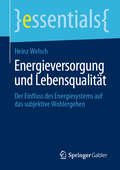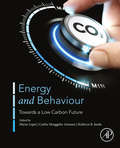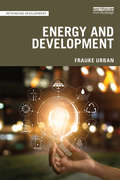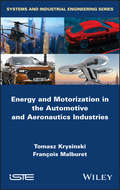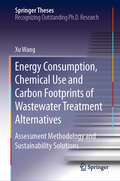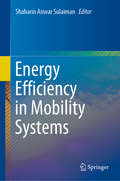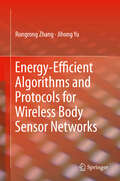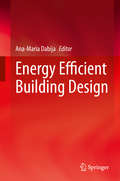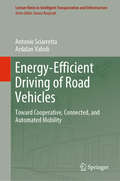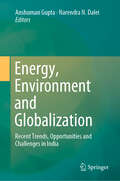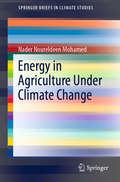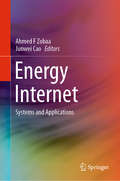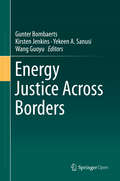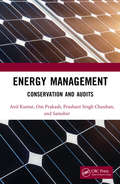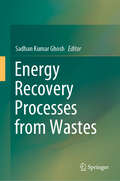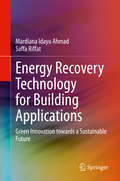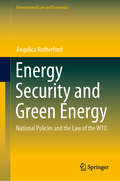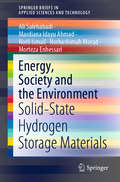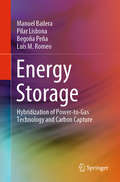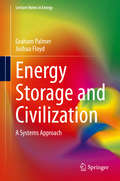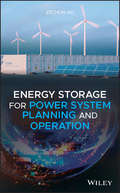- Table View
- List View
Energieversorgung und Lebensqualität: Der Einfluss des Energiesystems auf das subjektive Wohlergehen (essentials)
by Heinz WelschDie Energieversorgung ist weltweit im Umbruch. Die aktuelle Zufriedenheitsforschung hat neue Wege eröffnet, den Einfluss alternativer Versorgungsstrukturen auf die Lebensqualität zu untersuchen. Relevante Zusammenhänge umfassen einerseits Auswirkungen auf Umwelt und Klima, Sicherheitsrisiken und die von Energieanlagen ausgehenden Belästigungen und andererseits die Verfügbarkeit und Erschwinglichkeit von Energie. Heinz Welsch stellt den Einfluss dieser Faktoren auf das subjektive Wohlergehen anhand der neuesten Forschungsliteratur dar und zieht die Zufriedenheitsforschung für eine vergleichende Bewertung alternativer Versorgungstechnologien heran. Der Autor:Dr. Heinz Welsch ist Professor im Ruhestand für Volkswirtschaftslehre an der Universität Oldenburg. Er lehrte Umwelt-, Ressourcen- und Energieökonomik sowie Verhaltensökonomik und veröffentlichte zahlreiche Forschungsarbeiten auf diesen Gebieten.
Energy and Behaviour: Towards a Low Carbon Future
by Carlos Henggeler Antunes Marta Lopes Kathryn B. JandaChanges to energy behaviour — the role of people and organisations in energy production, use and efficiency — are critical to supporting a societal transition towards a low carbon and more sustainable future. However, which changes need to be made, by whom, and with what technologies are still very much under discussion. This book, developed by a diverse range of experts, presents an international and multi-faceted approach to the sociotechnical challenge of engaging people in energy systems and vice versa. By providing a multidisciplinary view of this field, it encourages critical thinking about core theories, quantitative and qualitative methodologies, and policy challenges. It concludes by addressing new areas where additional evidence is required for interventions and policy-making. It is designed to appeal to new entrants in the energy-efficiency and behaviour field, particularly those taking a quantitative approach to the topic. Concurrently, it recognizes ecological economist Herman Daly’s insight: what really counts is often not countable. Introduces the major disciplinary and interdisciplinary approaches to understanding energy and behaviourDelivers a cross-sectoral overview including energy behaviour in buildings, industry, transportation, smart grids, and smart citiesReviews a selection of innovative energy behaviour modelling approaches, including agent-based modelling, optimization, and decision supportCritically addresses the importance of interventions, policies, and regulatory design
Energy and Development (Rethinking Development)
by Frauke UrbanThis book explores the complex relationship between energy and development and discusses the core issues and concepts surrounding this growing area of research and policy. In the field of energy and development, the world faces two major challenges: (1) Providing energy access to the roughly one billion people worldwide who do not have access to electricity and the nearly three billion people worldwide who do not have access to clean cooking fuels; (2) achieving socioeconomic development while limiting global atmospheric temperature increases to 2 degrees Celsius to mitigate climate change. Taking stock of progress, Frauke Urban explores the key issues surrounding these goals and addresses the policy responses aimed at ending energy poverty and achieving sustainable development. She outlines various options for delivering energy access, analyses past and prospective energy transitions and examines the social, environmental, economic and technological implications of these possibilities. Taking a holistic and multi-disciplinary approach and containing useful teaching resources, Energy and Development provides a comprehensive overview of this complex field of study. This book will be a great resource for postgraduate and undergraduate students, scholars, practitioners and policymakers working in the fields of energy studies, international development, environmental studies, industrial engineering, as well as social sciences that relate to energy and development.
Energy and Development (Rethinking Development)
by Frauke UrbanThis book explores the complex relationship between energy and development and discusses the core issues and concepts surrounding this growing area of research and policy. In the field of energy and development, the world faces two major challenges: (1) Providing energy access to the roughly one billion people worldwide who do not have access to electricity and the nearly three billion people worldwide who do not have access to clean cooking fuels; (2) achieving socioeconomic development while limiting global atmospheric temperature increases to 2 degrees Celsius to mitigate climate change. Taking stock of progress, Frauke Urban explores the key issues surrounding these goals and addresses the policy responses aimed at ending energy poverty and achieving sustainable development. She outlines various options for delivering energy access, analyses past and prospective energy transitions and examines the social, environmental, economic and technological implications of these possibilities. Taking a holistic and multi-disciplinary approach and containing useful teaching resources, Energy and Development provides a comprehensive overview of this complex field of study. This book will be a great resource for postgraduate and undergraduate students, scholars, practitioners and policymakers working in the fields of energy studies, international development, environmental studies, industrial engineering, as well as social sciences that relate to energy and development.
Energy and Motorization in the Automotive and Aeronautics Industries
by Tomasz Krysinski François MalburetThe book is intended for students in engineering school or university, young engineers or newcomers in the automotive industry or aeronautics. The objective is to describe in a simple and clear way the problem of energy and motorization for the automobile, helicopters or airplanes. The front-end treatment of these industrial sectors makes it possible to analyze in an original way the similarities and differences of these different means of transport. For this, and based on current technologies and tomorrow, it specifically describes the problem of the energy requirement of cars and aircraft. The result is a search for an ideal motorization associated with the behavior of these different means of transport followed by the analysis of the performances of the various types of engines by covering gas turbines, internal combustion engines and electric motors. Transmission elements such as aerospace gearboxes or gearboxes are described as well as a chapter on energy storage means and their performance including batteries, supercapacitors, inertial or pneumatic storage, hydrogen or fuels from fossil fuels. A final chapter shows the interest and prospects of energy hybridization and electrification for the progressive replacement of fossil fuels. Beyond the technological descriptions, the book focuses on proposing basic sizing rules in order to justify certain performances and to give the reader the means to appropriate the basic know-how of these industrial sectors.
Energy and Motorization in the Automotive and Aeronautics Industries
by Tomasz Krysinski François MalburetThe book is intended for students in engineering school or university, young engineers or newcomers in the automotive industry or aeronautics. The objective is to describe in a simple and clear way the problem of energy and motorization for the automobile, helicopters or airplanes. The front-end treatment of these industrial sectors makes it possible to analyze in an original way the similarities and differences of these different means of transport. For this, and based on current technologies and tomorrow, it specifically describes the problem of the energy requirement of cars and aircraft. The result is a search for an ideal motorization associated with the behavior of these different means of transport followed by the analysis of the performances of the various types of engines by covering gas turbines, internal combustion engines and electric motors. Transmission elements such as aerospace gearboxes or gearboxes are described as well as a chapter on energy storage means and their performance including batteries, supercapacitors, inertial or pneumatic storage, hydrogen or fuels from fossil fuels. A final chapter shows the interest and prospects of energy hybridization and electrification for the progressive replacement of fossil fuels. Beyond the technological descriptions, the book focuses on proposing basic sizing rules in order to justify certain performances and to give the reader the means to appropriate the basic know-how of these industrial sectors.
Energy Consumption, Chemical Use and Carbon Footprints of Wastewater Treatment Alternatives: Assessment Methodology and Sustainability Solutions (Springer Theses)
by Xu WangThis thesis focuses on the energy, chemical and carbon implications of diverse wastewater treatment alternatives, and offers effective solutions for wastewater treatment plants (WWTPs) to achieve sustainability goals. The author first uses the life cycle philosophy to explore the environmental performance of several representative wastewater treatment systems, and then proposes a refined assessment framework, accompanying analytical toolkit and case study for further quantifying the environmental sustainability of various wastewater management scenarios. Allowing readers to gain a better understanding of the existing wastewater treatment technologies from a sustainability perspective, this book helps decision makers identify promising approaches to the environmentally friendly operation of WWTPs and make infrastructure investments that are appropriate for future changing conditions.
Energy Efficiency in Mobility Systems
by Shaharin Anwar SulaimanThis book highlights a diverse range of initiatives that have been launched to attain sustainable mobility systems, in particular regarding the energy efficiency aspect. It offers a valuable reference for various stakeholders in transportation systems, while also sharing new ideas on how transportation can meet the challenges of tomorrow.
Energy-Efficient Algorithms and Protocols for Wireless Body Sensor Networks
by Rongrong Zhang Jihong YuThis book provides a systematic treatment of the theoretical foundation and algorithmic tools necessary in the design of energy-efficient algorithms and protocols in wireless body sensor networks (WBSNs). These problems addressed in the book are of both fundamental and practical importance. Specifically, the book delivers a comprehensive treatment on the following problems ranging from theoretical modeling and analysis, to practical algorithm design and optimization: energy-efficient clustering-based leader election algorithms in WBSNs; MAC protocol for duty-cycling WBSNs with concurrent traffic; multi-channel broadcast algorithms in duty-cycling WBSNs; and energy-efficient sleep scheduling algorithms in WBSNs. Target readers of the book are researchers and advanced-level engineering students interested in acquiring in-depth knowledge on the topic and on WBSNs and their applications, both from theoretical and engineering perspective.
Energy Efficient Building Design
by Ana-Maria DabijaThis book is the result of recent research that deals with the built environment and innovative materials, carried out by specialists working in universities and centers of research in different professional fields ─ architecture, engineering, physics ─ and in an area that that spans from the Mediterranean Sea to the Persian Gulf, and from South Eastern Europe to the Middle East. This book takes the necessity of re-shaping the concept of building design in order to transform buildings from large scale energy consumers to energy savers and producers into consideration. The book is organized in two parts: theory and case studies. For the theoretical part, we chose from the wide range of sources that provide energy efficient materials and systems the two that seem to be endless: the sun and vegetation. Their use in building products represents a tool for specialists in the architectural design concept. The case-studies presented analyze different architectural programs, in different climates, from new buildings to rehabilitation approaches and from residential architecture to hospitals and sports arenas; each case emphasizes the interdisciplinarity of the building design activity in order to help readers gain a better understanding of the complex approach needed for energy efficient building design
Energy-Efficient Driving of Road Vehicles: Toward Cooperative, Connected, and Automated Mobility (Lecture Notes in Intelligent Transportation and Infrastructure)
by Antonio Sciarretta Ardalan VahidiThis book elaborates the science and engineering basis for energy-efficient driving in conventional and autonomous cars. After covering the physics of energy-efficient motion in conventional, hybrid, and electric powertrains, the book chiefly focuses on the energy-saving potential of connected and automated vehicles. It reveals how being connected to other vehicles and the infrastructure enables the anticipation of upcoming driving-relevant factors, e.g. hills, curves, slow traffic, state of traffic signals, and movements of nearby vehicles. In turn, automation allows vehicles to adjust their motion more precisely in anticipation of upcoming events, and to save energy. Lastly, the energy-efficient motion of connected and automated vehicles could have a harmonizing effect on mixed traffic, leading to additional energy savings for neighboring vehicles. Building on classical methods of powertrain modeling, optimization, and optimal control, the book further develops the theory of energy-efficient driving. In addition, it presents numerous theoretical and applied case studies that highlight the real-world implications of the theory developed. The book is chiefly intended for undergraduate and graduate engineering students and industry practitioners with a background in mechanical, electrical, or automotive engineering, computer science or robotics.
Energy, Environment and Globalization: Recent Trends, Opportunities and Challenges in India
by Anshuman Gupta Narendra N. DaleiThis book analyzes contemporary issues relating to energy, environment, and globalization in the Indian context. As a signatory to the Paris climate accord, India has reiterated its commitment to taking strong and positive steps toward climate change mitigation. However, as one of the fastest growing economies in the world, it is battling the effects of a steep rise in fossil fuel usage and pollution. Further, increasing globalization is leading to greater economic activity and production, resulting in additional energy use, which has a negative effect on the environment. The book argues that globalization need not have only a negative environmental impact; it can also have positive impact through the importation of environmentally sound technologies and implementing global compliance standards. The book is divided into three sections: The energy section discusses issues relating to the status of Indian natural gas market and the need for developing an efficient gas market in India; the economics and politics of sustainable energy in India; the challenges of thermal power and significance of clean thermal power generation in India; environmental and policy issues concerning energy use in urban India; the importance of energy use in developing Human Development Index (HDI); and issues relating to renewable energy in India. The environment section then examines topics such as the impact of global warming on local weather by examining the frequency of extreme weather events such as drought and floods, and their impact on farming activities in the Indian state of Odisha; the importance of according the economic value to environmentally significant things like national park , mangroves, etc. for sustainable development; the role of environmental accounting for ecological sustainability and ecotourism; and environmental concerns increasingly gaining traction among the corporate sector for their long-run benefits . Lastly, the third section addresses issues relating to the challenges and opportunities of globalization, such as the interface between globalization and environment; managing India’s business interest in proposing new Bilateral Investment Treaty (BIT); the challenges being faced by Indian exports and their revival; and making Indian SMEs competitive. As such, it is an invaluable resource for policymakers, researchers, practitioners and students in the field of energy, environment and trade economics.
Energy in Agriculture Under Climate Change (SpringerBriefs in Climate Studies)
by Nader Noureldeen MohamedThis book discusses the role of energy in agriculture which reaches 30%, and the role of agriculture in energy where the water shred by 17% in total electricity generation in addition to the role of bioenergy as a source of liquid energy. Climate change and global heating will increase the temperature and that will affect plant growth, water availability and the share of electricity in agriculture and other energy phases in agriculture. Global heating means more water pumping, more uses of fertilizers and pesticides in which intensive power consumption in addition to need of more electricity for air-condition inside the greenhouses, the manufacturing of hormone and plant growth organizers will also consume more energy. Finally, the book explains why the water, energy and food become one nexus and the interaction and interference between them.This book will have valuable information for both students and faculties of engineering and agriculture in addition to research centers, water institutions and climate change specialists.
Energy Internet: Systems and Applications
by Ahmed F Zobaa Junwei CaoThis textbook is the first of its kind to comprehensively describe the energy Internet, a vast network that efficiently supplies electricity to anyone anywhere and is an internet based wide area network for information and energy fusion. The chapters are organized into five parts: Architecture and Design, Energy Switching and Routing, Information and Communication, Energy Management Systems and Energy Market and Trading, and capture the spectrum of this exponential transformation, while also presenting the plethora of open problems that this transformation poses for researchers from mixed academic backgrounds. The scope includes key technologies on distributed energy sources, microgrids, energy storage, solar and wind energy, power grid, smart grid, power quality, power electronics, data centers, distributed computing and networking, cloud computing and big data, and software-defined networking. The book presents the basic principles of energy internet and emphasizes the current research trends in the field of energy Internet at an advanced level. It includes instructor materials, case-studies, and worked examples throughout. This is an ideal resource for students in advanced graduate-level courses and special topics in energy, information and control systems, and is a useful tool for utility engineers who seek an intuitive understanding of the emerging applications of energy Internet.
Energy Justice Across Borders
by Gunter Bombaerts Kirsten Jenkins Yekeen A. Sanusi Wang GuoyuThis book is open access under a CC BY 4.0 license.We must find new and innovative ways of conceptualizing transboundary energy issues, of embedding concerns of ethics or justice into energy policy, and of operationalizing response to them. This book stems from the emergent gap; the need for comparative approaches to energy justice, and for those that consider ethical traditions that go beyond the classical Western approach. This edited volume unites the fields of energy justice and comparative philosophy to provide an overarching global perspective and approach to applying energy ethics. We contribute to this purpose in four sections: setting the scene, practice, applying theory to practice, and theoretical approaches. Through the chapters featured in the volume, we position the book as one that contributes to energy justice scholarship across borders of nations, borders of ways of thinking and borders of disciplines. The outcome will be of interest to undergraduate and graduate students studying energy justice, ethics and environment, as well as energy scholars, policy makers, and energy analysts.
Energy Management: Conservation and Audits
by Anil Kumar Om Prakash Prashant Singh Chauhan Samsher GautamEnergy Management: Conservation and Audit discusses the energy scenario, including energy conservation, management, and audit, along with the methodology supported by industrial examples. Energy economics of systems has been elaborated with concepts of life cycle assessment and costing, and rate of return. Topics such as energy storage, co-generation, and waste heat recovery to energy efficiency have discussed. The challenges faced in conserving energy sources (steam and electricity) have elaborated along with the improvements in the lighting sector. Further, it covers optimization procedures for the development in the industry related to energy conservation. The researchers, senior undergraduate, and graduate students focused on Energy Management, Sustainable Energy, Renewable Energy, Energy Audits, and Energy Conservation. This book covers current information related to energy management and includes energy audit and review all the leading equipment (boilers, CHP, pumps, heat exchangers) as well as procedural frameworks (energy audits, action planning, monitoring). It includes energy production and management from an industrial perspective, along with highlighting the various processes involved in energy conservation and auditing in various sectors and associated methods. It also explores future energy options and directions for energy security and sustainability.
Energy Management: Conservation and Audits
by Anil Kumar Om Prakash Prashant Singh Chauhan Samsher GautamEnergy Management: Conservation and Audit discusses the energy scenario, including energy conservation, management, and audit, along with the methodology supported by industrial examples. Energy economics of systems has been elaborated with concepts of life cycle assessment and costing, and rate of return. Topics such as energy storage, co-generation, and waste heat recovery to energy efficiency have discussed. The challenges faced in conserving energy sources (steam and electricity) have elaborated along with the improvements in the lighting sector. Further, it covers optimization procedures for the development in the industry related to energy conservation. The researchers, senior undergraduate, and graduate students focused on Energy Management, Sustainable Energy, Renewable Energy, Energy Audits, and Energy Conservation. This book covers current information related to energy management and includes energy audit and review all the leading equipment (boilers, CHP, pumps, heat exchangers) as well as procedural frameworks (energy audits, action planning, monitoring). It includes energy production and management from an industrial perspective, along with highlighting the various processes involved in energy conservation and auditing in various sectors and associated methods. It also explores future energy options and directions for energy security and sustainability.
Energy Recovery Processes from Wastes
by Sadhan Kumar GhoshThe book focuses on a global issue—municipal solid waste management (MSWM) and presents the most effective solutions based on energy recovery processes. There is huge potential in employing different technologies and modern management methodology for recovering energy from various waste streams to establish a sustainable and circular economy. In several countries, energy recovery from municipal solid wastes (MSW) is seen as a way of reducing the negative impact of waste on the environment and also reducing the burden on land resources. The book primarily focuses on highlighting the latest insights into energy recovery from various waste streams in different countries, with a particular emphasis on India. Further, it paves the way for sustainability in the energy sector as a whole by addressing waste management issues and simultaneous energy recovery. The chapters present high-quality research papers selected and presented in the conference, IconSWM 2018.
Energy Recovery Technology for Building Applications: Green Innovation towards a Sustainable Future
by Mardiana Idayu Ahmad Saffa RiffatThis book discusses energy recovery technology, a green innovation that can be used in buildings. This technology reduces energy consumption in buildings and provides energy savings to conventional mechanical ventilation systems. Divided into eight chapters, the book provides in-depth technical information, state-of-the-art research, and latest developments in the energy recovery technology field. Case-studies describe worldwide applications of energy recovery technology and its integrated system for building services. This book will be used as a general and technical reference book for students, engineers, professionals, practitioners, scientists, and researchers seeking to reduce energy consumption of buildings in various climatic conditions.Presents an overview of energy consumption scenarios in buildings and the needs for energy-efficient technologies at regional and global levels;Explains models and methods of energy recovery technology performance evaluation;Inspires further research into energy recovery technology for building applications.
Energy Security and Green Energy: National Policies and the Law of the WTO (International Law and Economics)
by Angelica RutherfordThis book shows how the links between energy security and national and international law and policies on green energy pose challenges to a transition towards a green energy system. Based on empirical work carried out in two very different country case studies – Great Britain and Brazil – this book attempts to foster a better understanding of the role played by energy security in constructing and deconstructing green energy policy initiatives. The broad range of views raised in national contexts leads to legal disputes in international forums when attempts are made to address the issues of this energy security/green energy interplay. As such, building on the findings of the case studies, this book then analyses the interplay between energy security and green energy development in international trade law as encapsulated in the law of the World Trade Organisation (WTO). Finally, the author proposes a way forward in creating the legal space in the law of the WTO for trade restrictive measures aimed at ensuring green energy security.
Energy, Society and the Environment: Solid-State Hydrogen Storage Materials (SpringerBriefs in Applied Sciences and Technology)
by Ali Salehabadi Mardiana Idayu Ahmad Norli Ismail Norhashimah Morad Morteza EnhessariThis book provides a comprehensive and contemporary overview of advances in energy and energy storage technologies. Although the coverage is varied and diverse, the book also addresses unifying patterns and trends in order to enrich readers’ understanding of energy and energy storage systems, particularly hydrogen energy storage, including e.g. their morphology, porosity and material structure. Readers will also gain insights into the hydrogen storage performance landscape, based on data released by the US Department of Energy (DOE), providing a basis for understanding real-world applications. The book also discusses the superior hydrogen storage performance of solid-state materials and explores the physical and chemical properties that can potentially affect their performance.
Energy Storage: Hybridization of Power-to-Gas Technology and Carbon Capture (Springerbriefs In Energy Ser.)
by Manuel Bailera Pilar Lisbona Begoña Peña Luis M. RomeoThis book presents a detailed analysis of Power-to-Gas, a promising energy storage technology. It discusses the main mechanisms involved, and presents two Power-to-Gas and carbon capture hybridizations. The book begins by providing an introduction to energy storage technologies. It then reviews a number of Power-to-Gas projects now in progress, highlighting the current barriers to commercializing the technology. Moreover, the book presents two novel Power-to-Gas hybridizations, which improve the technology’s applicability in terms of efficiency, utilization of resources and profitability. Given its scope, the book will be of interest to graduate students, researchers and practitioners in the fields of engineering and energy.
Energy Storage and Civilization: A Systems Approach (Lecture Notes in Energy #40)
by Graham Palmer Joshua FloydFossil fuels comprise the accumulation of prehistoric biomass that was energised by sunlight, and formed by earth system dynamics. Fossil fuels can be conceptualized as stored energy stocks that can be readily converted to power flows, on demand. A transition from a reliance on stored energy stocks, to renewable energy flows, will require a replication of energy storage by technological devices and energy conversion methods. Most analyses of energy storage focus solely on the economic-technical properties of storage within incumbent energy systems. This book broadens the scope of the study of storage by placing it within a broader, historical, biophysical framework. The role and value of storage is examined from first principles, and framed within the contemporary context of electrical grids and markets. The energy-economic cost of electrical storage may be critical to the efficacy of high penetration renewable scenarios, and understanding the costs and benefits of storage is needed for a proper assessment of storage in energy transition studies. This book provides a starting point for engineers, scientists and energy analysts for exploring the role of storage in energy transition studies, and for gaining an appreciation of the biophysical constraints of storage.
Energy Storage for Power System Planning and Operation
by Zechun HuAn authoritative guide to large-scale energy storage technologies and applications for power system planning and operation To reduce the dependence on fossil energy, renewable energy generation (represented by wind power and photovoltaic power generation) is a growing field worldwide. Energy Storage for Power System Planning and Operation offers an authoritative introduction to the rapidly evolving field of energy storage systems. Written by a noted expert on the topic, the book outlines a valuable framework for understanding the existing and most recent advances in technologies for integrating energy storage applications with power systems. Filled with full-color illustrations, the book reviews the state-of-the-art of energy storage systems and includes illustrative system models and simulations. The author explores the various techniques that can be employed for energy storage that is compatible with renewable energy generation. Designed as a practical resource, the book examines in detail the aspects of system optimization, planning, and dispatch. This important book, • Provides an introduction to the systematically different energy storage techniques with deployment potential in power systems • Models various energy storage systems for mathematical formulation and simulations • Contains a review of the techniques for integrating and operating energy storage with renewable energy generation • Analyses how to optimize power systems with energy storage, at both the transmission and distribution system levels • Shows how to optimize planning, siting, and sizing of energy storage for a range of purposes Written for power system engineers and researchers, Energy Storage for Power System Planning and Operation introduces the application of large-scale energy storage for the optimal operation and planning of power systems.
Energy Storage for Power System Planning and Operation
by Zechun HuAn authoritative guide to large-scale energy storage technologies and applications for power system planning and operation To reduce the dependence on fossil energy, renewable energy generation (represented by wind power and photovoltaic power generation) is a growing field worldwide. Energy Storage for Power System Planning and Operation offers an authoritative introduction to the rapidly evolving field of energy storage systems. Written by a noted expert on the topic, the book outlines a valuable framework for understanding the existing and most recent advances in technologies for integrating energy storage applications with power systems. Filled with full-color illustrations, the book reviews the state-of-the-art of energy storage systems and includes illustrative system models and simulations. The author explores the various techniques that can be employed for energy storage that is compatible with renewable energy generation. Designed as a practical resource, the book examines in detail the aspects of system optimization, planning, and dispatch. This important book, • Provides an introduction to the systematically different energy storage techniques with deployment potential in power systems • Models various energy storage systems for mathematical formulation and simulations • Contains a review of the techniques for integrating and operating energy storage with renewable energy generation • Analyses how to optimize power systems with energy storage, at both the transmission and distribution system levels • Shows how to optimize planning, siting, and sizing of energy storage for a range of purposes Written for power system engineers and researchers, Energy Storage for Power System Planning and Operation introduces the application of large-scale energy storage for the optimal operation and planning of power systems.
